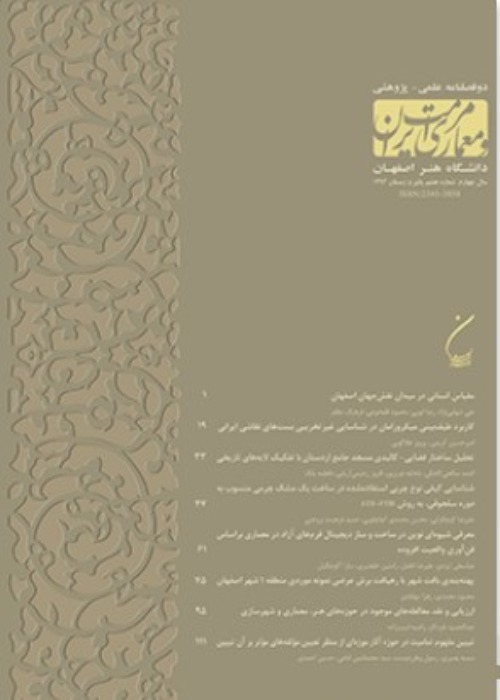Analyzing the Kufic Writings of Qavam al-Din Shirazi's Architectural Ornamentation in Gazirgah, Herat
Author(s):
Abstract:
The Perso-Islamic architectural ornaments have always been of great importance for the scholars of art and architecture. The grand master, Qavam al-Din ibn Zayn al-Din Shirazi (active during 813-842 A.H.), has been one of the most influential architects in this style of architecture and most renowned for his leading prominence in this style, especially its relevant architectural ornamentations. This study explores the designing style of Qavam al-Din Shirazi in the Kufic Moaqqali patterns and inscriptions within the square Kufic motifs, bearing the Ayah 84, Surah 17, Al-Isra (here briefly called square motif), located in the Shrine of Khwaja Abdullah Ansari in Gazirgah, Herat. The aim of this study is to discover the link between this square motif and its sources of inspiration. The question is what underlying design system has been the basis of the square motif in this shrine. Thus, this research follows a descriptive-analytical method. In the process of DATA collection, apart from using the written historical sources and the writings of Khwaja Abdullah Ansari, this square motif has been kept under focus as our primary evidence and the first-hand observation source.
Therefore, through examining various resources and information on the subject, including the interpretation offered by Khwaja Abdullah Ansari in a chapter from his book, Maydan-i Iradat (the field of Willfulness) from the book Sad Maydan (The One Hundred Fields), it is understandable that the aforementioned verse alludes towards the significance of the intention in prayers; such an intention which would serve as the spiritual rites of the prayer during an inner journey, beginning with a noble intention; otherwise, if the initial intention is flawed, the entire journey would be considered futile. This seems to be the foundation upon which Qavam al-Din Shirazi has developed the conception of his design. On one hand, considering the quadruple arrangement of the verse on all the four sides of the square motif, and on the other hand, the repetition of the Namazs (prayers) content within the circumscribed Kufic writings, organized in the moaqqali design, it is conceived that through circumscribing the content of the square motif by the verse Qul kullun yaAAmalu AAala shakilatihi (Say: everyone acts according to his own disposition), he has visually and objectively infused its connotation into the circumscribed textual content; in other words, in this manner, he has actualized a visual interpretation for the concepts introduced by Khwaja Abdullah Ansari in the form of the architectural ornamentation.
Therefore, through examining various resources and information on the subject, including the interpretation offered by Khwaja Abdullah Ansari in a chapter from his book, Maydan-i Iradat (the field of Willfulness) from the book Sad Maydan (The One Hundred Fields), it is understandable that the aforementioned verse alludes towards the significance of the intention in prayers; such an intention which would serve as the spiritual rites of the prayer during an inner journey, beginning with a noble intention; otherwise, if the initial intention is flawed, the entire journey would be considered futile. This seems to be the foundation upon which Qavam al-Din Shirazi has developed the conception of his design. On one hand, considering the quadruple arrangement of the verse on all the four sides of the square motif, and on the other hand, the repetition of the Namazs (prayers) content within the circumscribed Kufic writings, organized in the moaqqali design, it is conceived that through circumscribing the content of the square motif by the verse Qul kullun yaAAmalu AAala shakilatihi (Say: everyone acts according to his own disposition), he has visually and objectively infused its connotation into the circumscribed textual content; in other words, in this manner, he has actualized a visual interpretation for the concepts introduced by Khwaja Abdullah Ansari in the form of the architectural ornamentation.
Keywords:
Language:
Persian
Published:
Maremat & memari-e Iran, Volume:5 Issue: 10, 2016
Pages:
105 to 122
magiran.com/p1524432
دانلود و مطالعه متن این مقاله با یکی از روشهای زیر امکان پذیر است:
اشتراک شخصی
با عضویت و پرداخت آنلاین حق اشتراک یکساله به مبلغ 1,390,000ريال میتوانید 70 عنوان مطلب دانلود کنید!
اشتراک سازمانی
به کتابخانه دانشگاه یا محل کار خود پیشنهاد کنید تا اشتراک سازمانی این پایگاه را برای دسترسی نامحدود همه کاربران به متن مطالب تهیه نمایند!
توجه!
- حق عضویت دریافتی صرف حمایت از نشریات عضو و نگهداری، تکمیل و توسعه مگیران میشود.
- پرداخت حق اشتراک و دانلود مقالات اجازه بازنشر آن در سایر رسانههای چاپی و دیجیتال را به کاربر نمیدهد.
In order to view content subscription is required
Personal subscription
Subscribe magiran.com for 70 € euros via PayPal and download 70 articles during a year.
Organization subscription
Please contact us to subscribe your university or library for unlimited access!



